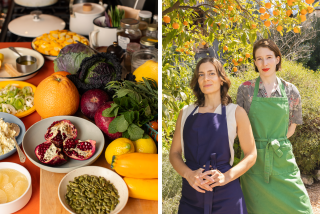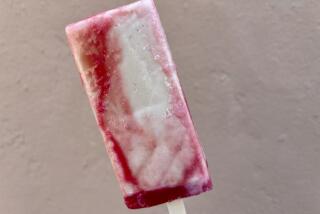The white gloves are off
- Share via
Back before mesclun started to seem as everyday as iceberg lettuce, watercress was in my salad spinner about as often as Grey Poupon was in my vinaigrette. The little green leaves had the peppery kick of then-exotic arugula but were as affordable, accessible and dependable as supermarket mustard.
And that made them too easy to give up once every store outside of 7-Eleven started carrying carloads of equally pungent leaves that not only needed no washing, trimming or even dressing, but also brought home a lot more snob appeal for a little more money.
This spring, though, watercress is looking tempting again. Partly it’s because I’ve been remembering eating it wild as a kid in Arizona, where it grew like a weed along the Verde River once the weather warmed up in the mountains. But I also started thinking that there had to be more to toss into a salad bowl than a bunch of greens I could get in any restaurant anywhere. What trend-conscious chef, after all, even prints the word “watercress” on a menu anymore?
When I went looking, watercress was stowed just where it always was, leaves-down in a bin of water in the herb-and-greens section of my neighborhood stores.
The price was still below reasonable (99 cents for a bunch big enough to make a salad for two or more), and the quality was still way above the state of the romaine and red leaf lettuce wilting nearby like mesclun’s poor relations.
The care and handling also were easier than I remembered: The leaves just had to be pulled off their tough stems and dunked in cold water a few times, then spun dry. Unlike big, floppy lettuce leaves, watercress doesn’t retain water, so it’s ready to dress fast.
Once I started playing around, the salad potential seemed unlimited. Because of its pungency, watercress goes with many good things in the buttery category -- avocado, cheese, smoked salmon, sauteed shiitakes and barely boiled eggs -- and many more in the spicy-sweet-crunchy division: sliced chorizo, roasted peppers, pears and apples, and toasted nuts, from almonds to walnuts.
Because the leaves are so aggressive, the dressing doesn’t have to be as submissive as usual. A combination of soy sauce and lemon is an even better starting point than true Dijon mustard, and a nut oil, such as hazelnut, walnut or almond, smooths out the flavor even more.
The superiority of watercress over mesclun was most clear once I started cooking it. Throw the high-priced greens into a soup pot, and you don’t want to watch what happens. But if you add sturdy watercress to stock simmering with leeks and potatoes, you’re not just halfway to a French classic (potage a la cressoniere) but far down the road to a sophisticated soup with Stilton and pecans. The leaves wilt just enough to mellow their bite without losing their gorgeous green color.
Watercress also can be stir-fried, or pureed with butter or cream and a good companion vegetable such as potatoes or peas to make a side dish. Finely chopped leaves are good in eggs: scrambled or deviled or in a salad for sandwiches. And if you use enough of it, watercress can substitute for sorrel in the classic cream sauce of springtime, for salmon or veal.
The flavor is most potent raw, which makes watercress better than wimpy spinach in a dip made with whipped cream cheese, creme fraiche or sour cream. Just mince the leaves from a small bunch and mix them into about a cup and a half of whatever “cream” you choose, then add a little salt and hot sauce if you like. A couple of strips of smoky bacon, fried crisp and crumbled fine, or some finely chopped prosciutto also can be mixed in. You can dunk chips into this or spread it on crackers or toasted rounds of baguette as canapes.
Now that I’ve gotten reacquainted with standard-issue watercress, I’ve noticed cute little leaves with a distinctive taste seem to be popping up as a garnish on more and more dainty but elaborate appetizers in ambitious restaurants. When I ask, the waiters always say they’re cress, different varieties with a similar flavor that are newish entries in the field of microgreens.
And that means this symbol of spring may not be able to hang on to its status as the overlooked green. At the top of the food chain, the opposite of super-sizing always seems to reverse a vegetable’s fortunes.
*
Watercress and Stilton soup
Total time: 1 hour
Servings: 4 to 6
Note: Adapted from “In the Hands of a Chef” by Jody Adams and Ken Rivard (Morrow, 2002).
2 tablespoons butter
2 medium leeks, white parts only, washed well and thinly sliced
Coarse salt
Freshly ground white pepper
4 cups vegetable or chicken stock
2 baking potatoes, peeled, quartered
2 bunches watercress, washed, tough stems removed, coarsely chopped
1 cup half-and-half or whipping cream
2-3 ounces Stilton cheese,
crumbled
A few sprigs watercress
Chopped toasted pecans, for garnish
1. Melt the butter in a heavy pot over medium heat. Add the leeks, season with salt and pepper and cook, stirring, until soft, 8 minutes. Add the stock and potatoes and bring to a boil. Reduce the heat and simmer, uncovered, until the potatoes are tender, 25 to 30 minutes. Stir in the watercress and cook until wilted but bright green, 2 to 3 minutes.
2. Carefully transfer to a blender or food processor in batches and puree until smooth. Strain through a coarse sieve into a clean saucepan and bring to a gentle simmer.
3. Stir in half-and-half and cheese until the cheese is melted. Adjust the seasoning. Garnish with sprigs of watercress and pecans.
Each of 6 servings: 217 calories; 540 mg. sodium; 41 mg. cholesterol; 12 grams fat; 8 grams saturated fat; 19 grams carbohydrates; 7 grams protein; 2 grams fiber.
*
Watercress and avocado salad with lemon-soy dressing
Total time: 20 minutes
Servings: 4 to 6
2 tablespoons olive oil
12 medium shiitake mushrooms, stemmed and sliced
2 teaspoons soy sauce, divided
About 1-1 1/2 tablespoons lemon juice
3 tablespoons hazelnut or walnut oil
Freshly ground pepper
2 bunches watercress, washed and dried, tough stems removed
1 large ripe avocado
4 small piquillo peppers, or 2 roasted red bell peppers, seeded and sliced
1/4 cup sliced almonds, toasted
1. Heat the olive oil in a medium skillet over medium-high heat. Add shiitakes and cook, stirring or shaking the pan constantly, until tender. Drizzle with 1 teaspoon soy sauce and continue cooking until almost crisp. Set aside.
2. In a small bowl, whisk together the remaining soy sauce with the lemon juice and pepper to taste. Add the hazelnut oil and whisk until emulsified. Taste and adjust the seasoning.
3. Place the watercress in a large salad bowl. Cut the avocado into quarters lengthwise, remove the pit and cut crosswise into thin slices. Slide the fruit off the skin into the bowl. Add the peppers and shiitakes and toss well. Add just enough dressing to coat and toss again. Divide the mixture among serving plates and sprinkle with almonds.
Each of 6 servings: 239 calories; 127 mg. sodium; 0 cholesterol; 21 grams fat; 3 grams saturated fat; 13 grams carbohydrates; 3 grams protein; 5 grams fiber.
More to Read
Eat your way across L.A.
Get our weekly Tasting Notes newsletter for reviews, news and more.
You may occasionally receive promotional content from the Los Angeles Times.










